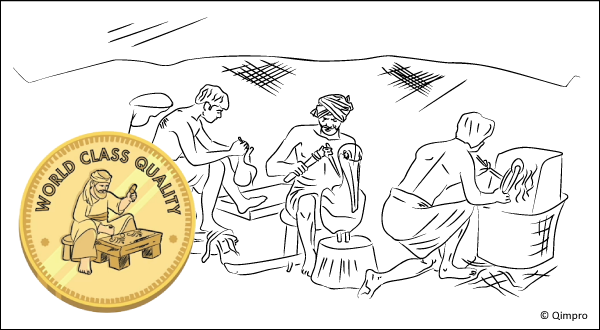History of MANAGING FOR QUALITY

Quality is a timeless concept.
As we all know, humans have always faced problems of quality. For example, primitive food gatherers had to discover which fruits and vegetables were edible and which were poisonous. Also, primitive hunters had to learn which type of trees provided the best wood for making bows and arrows. Each of them intuitively looked for good quality.
Even for these primitive people, the nuclear human organization unit was the family. Each family lived in isolation, across the mountains and rivers of India. These families were forced to be self-sufficient, in order to meet their own needs of food, clothing, and shelter. So they adopted practices for division of work among family members.
Since production was for self-use, the design, production, and use of the products were all carried out by the same persons. While their methods were primitive, their coordination was extraordinary. The same human beings received all inputs, diagnosed the work, and took appropriate remedial actions.
Over time, villages were created to serve other essential human requirements such as mutual defence and social needs. The creation of the village opened the way to further division of labour and to development of specialized skills. This catalysed the birth of farmers, hunters, fishermen, and craftsmen of all varieties – weavers, potters, shoemakers and so on.
By repeating the same work cycle again and again, the craftsmen became intimately familiar with the:
- Materials used
- Tools required
- Process steps
- Finished product features.
The cycle also included selling the finished product to users, and receiving their feedback of product performance. This was the earliest evidence of informal quality management.
As villages grew they needed multiple craftsmen who subsequently competed with each other. Much of this happened in the village marketplace, where craftsmen and buyers met on scheduled market days. The suppliers and buyers had experience with the products, and consequently, the quality also. They judged quality with human senses.
Within the village both producer and buyer engaged in inspection of goods. Producer and buyer both lived in the same village. Each was subject to scrutiny and character evaluation by the villagers. For the craftsman the stakes were high. His status and livelihood, including that of his family, were closely linked to his reputation as a competent and honest craftsman. This practice is widely applied, to this day, in village markets all over the world.
I learned this lesson from Dr J M Juran, the Quality Guru.
